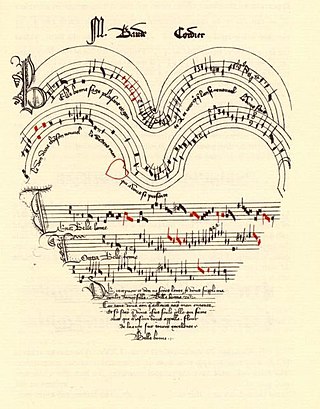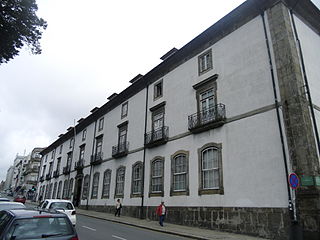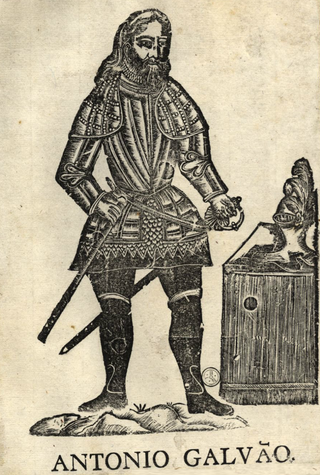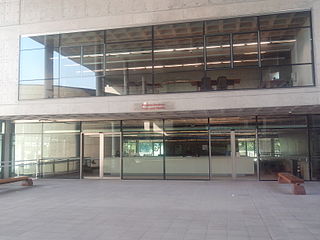
Albert of Stade was a German monk, historian and poet.

The Chantilly Codex is a manuscript of medieval music containing pieces from the style known as the Ars subtilior. It is held in the museum at the Château de Chantilly in Chantilly, Oise.

The Padrón Real, known after 2 August 1527 as the Padrón General, was the official and secret Spanish master map used as a template for the maps present on all Spanish ships during the 16th century. It was kept in Seville, Spain by the Casa de Contratación. Ship pilots were required to use a copy of the official government chart, or risk the penalty of a 50 doblas fine. The map probably included a large-scale chart that hung on the wall of the old Alcázar of Seville. Well-known official cartographers and pilots who contributed to and used the map included Amerigo Vespucci, Diogo Ribeiro, Sebastian Cabot, Alonzo de Santa Cruz, and Juan Lopez de Velasco.
Juan Bautista José Cabanilles was a Spanish organist and composer at Valencia Cathedral. He is considered by many to have been the greatest Spanish Baroque composer, and has been called the Spanish Bach.

The Barcelona Mass is a polyphonic mass written around 1360. Together with the Messe de Nostre Dame by Guillaume de Machaut and those of Toulouse, Tournai and the Sorbonne, it is one of the earliest preserved complete polyphonic musical settings of the Ordinary of the Mass. It is believed to belong to the repertoire of the Papal court at Avignon and is also linked to the chapel of King Martin I of Aragon.

The Roman Catholic Diocese of Crato is located in the ecclesiastical province of Fortaleza in Brazil.

Francisco de Holanda was a Portuguese artist, architect, and art essayist. He served as a court painter for the kings João III of Portugal and Sebastião of Portugal. He was an influential figure in the Portuguese Renaissance. After a stay in Italy, he returned to Portugal and contributed to the propagation of the Italianate style mainly through his writings. In 1548 he completed a manuscript entitled Da pintura antigua which was the first treatise on painting written in the Iberian peninsula.

The Cancionero de Palacio, or Cancionero Musical de Palacio (CMP), also known as Cancionero de Barbieri, is a Spanish manuscript of Renaissance music. The works in it were compiled during a time span of around 40 years, from the mid-1470s until the beginning of the 16th century, approximately coinciding with the reign of the Catholic Monarchs.

The Municipal Library of Porto is a library located in the civil parish of Bonfim, municipality of Porto in the Portuguese district of the same name.

António Galvão, also known as Antonio Galvano, was a Portuguese soldier, chronicler and administrator in the Maluku islands, and a Renaissance historian who was the first person to present a comprehensive report of the leading voyages and explorers up to 1550 by Portuguese explorers and those of other nationalities. His works, especially the Treaty of Discovery that was published in Lisbon in 1563 and in English by Richard Hakluyt in 1601, are notably accurate.

Salvator Mundi is a painting attributed in whole or in part to the Italian High Renaissance artist Leonardo da Vinci, dated to c. 1499–1510. Long thought to be a copy of a lost original veiled with overpainting, it was rediscovered, restored, and included in an exhibition of Leonardo's work at the National Gallery, London, in 2011–2012. Christie's, who sold the work in 2017, stated that most leading scholars consider it an original work by Leonardo, but this attribution has been disputed by other leading specialists, some of whom propose that he only contributed certain elements; and others who believe that the extensive restoration prevents a definitive attribution.

The Biblioteca Palafoxiana is a library in Puebla City's historic centre, in the Mexican state of Puebla. Founded in 1646, it is recognized by the UNESCO for being the first and oldest public library in the Americas, It has more than 45,000 books and manuscripts, ranging from the 15th to the 20th century. In 2005, it was listed on UNESCO's Memory of the World Register.

Events in the year 1916 in Brazil.

The Biblioteca Brasiliana Guita e José Mindlin (BBM) is a library in São Paulo, Brazil. The library was created to hold the Brazilian collection gathered throughout eighty years by José Mindlin and his wife Guita, began in January 2005 for important works for understanding the culture and history of Brazil compose the collection donated to the University of São Paulo in 2006. Among them, there are works of literature and history, travellers’ accounts, historical and literary manuscripts, documents, journals, maps, scientific and didactic books, iconography and artists’ books.

The Gradual of Manuel I of Portugal is a kyriale or gradual dated c. 1500, originally owned by King Manuel I of Portugal. It contains Gregorian chant settings for the Ordinary of the Mass, comprising a total of eighteen complete polyphonic Masses by the foremost contemporary composers, among them Jacobus Barbireau, Alexander Agricola, Pierre de la Rue, Marbrianus de Orto, Josquin des Prez, Johannes Ghiselin, and Antoine Brumel.

The Institute of Brazilian Studies, is a specialized research unit of the University of São Paulo, founded in 1962 on the initiative of Professor Sérgio Buarque de Holanda. It aims to research and document the history and culture of Brazil.















